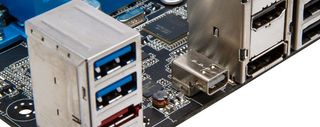Thunderbolt motherboards on their way

Just 15 months after the technology first appeared in a commercial form, ASUS and MSI have finally announced the first PC motherboards that will ship with built in Thunderbolt ports.
Thunderbolt , if you're aware of it all, may sound like a tedious hard drive technology, but it's got an enormous amount of potential for PC gaming. With these two boards, we may finally be in the era of the modular PC – which doesn't have to be opened up for upgrades.
It means, potentially, external hard drives that are as quick as internal SSDs and plug in graphics cards that really work. Much as I like to tinker inside my PC's case, this is big.
Thunderbolt, which was developed by Intel under the codename LightPeak, debuted in the MacBook Pro last February, but take up of the techology hasn't been especially fast. Apple quickly shifted its monitor range over to support Thunderbolt, which is useful in professional environments because it allows screens to be daisy chained together. Other than a few very expensive external drives and backup systems, though, there's not been a lot of outside interest.
The tech itself acts as an extension of the motherboard's PCI Express bus – the one that graphics card interface with – and was originally designed to use fibre optics. Current Thunderbolt designs are all copper, but still capable of 20Gbps bidirectionally. They also combine a DisplayPort feed for video out, using Apple's annoyingly proprietary miniDisplayPort adaptor. The advantage is that with a Thunderbolt monitor, you only need one small connector to attach both the screen and a peripherals hub.
The boards in question are ASUS' P8Z77V Premium and MSI's Z77A-GD80. Thunderbolt is natively supported in Intel's recent Z77 chipset, so expect many more soon.

It's worth pointing out that in ASUS' case, you shouldn't confuse Thunderbolt with ThunderBolt, it's cheekily named audio add-in cards bundled with some high end motherboards recently.
PC Gamer Newsletter
Sign up to get the best content of the week, and great gaming deals, as picked by the editors.
Here's what's really exciting, though. Although these are the first PC motherboards with Thunderbolt built in, they aren't the first non-Apple PCs. Late last year, Sony released its superthin Vaio Z which used Thunderbolt technology in a USB port to attach an external dock that housed a GPU. So it was ultra light in the bag but not a terrible games machine when plugged in. While obviously that's not much use for a desktop PC, to me it's the future of gaming. The more Thunderbolt compatible machines there are out there, the more chance there is of decent external graphics becoming commoditised in a way that the industry has been trying but failing to achieve for years.
Most Popular



